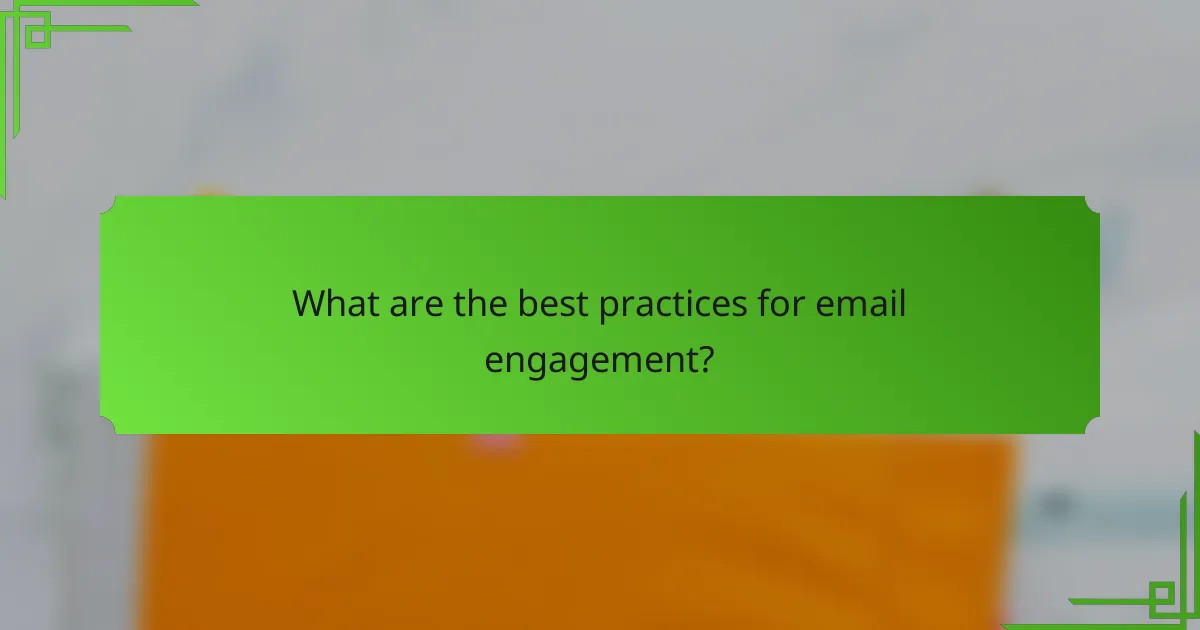Email marketing success hinges on effective subject lines, which play a crucial role in determining open rates and overall engagement. By focusing on clarity, relevance, and audience resonance, marketers can significantly boost the likelihood of their emails being opened. Additionally, implementing targeted strategies such as list segmentation and compelling content can further enhance engagement and foster stronger customer relationships.

How to improve email subject lines for higher open rates?
To enhance email subject lines for better open rates, focus on clarity, relevance, and engagement. Crafting compelling subject lines that resonate with your audience can significantly increase the likelihood of your emails being opened.
Use personalization techniques
Personalization involves tailoring subject lines to individual recipients, which can lead to higher engagement. Using the recipient’s name or referencing their past interactions can make your emails feel more relevant and appealing.
For example, a subject line like “John, your exclusive offer awaits!” directly addresses the recipient, increasing the chances of them opening the email. Aim to incorporate personalization in at least 30% of your subject lines for optimal results.
Incorporate urgency and exclusivity
Creating a sense of urgency or exclusivity can motivate recipients to act quickly. Phrases like “Limited time offer” or “Only for our VIP members” can prompt immediate responses.
Consider using countdown timers in your emails or highlighting limited stock to reinforce urgency. This tactic can boost open rates by appealing to the fear of missing out (FOMO), which is a powerful motivator for many consumers.
Utilize A/B testing for optimization
A/B testing allows you to compare different subject lines to determine which one performs better. By sending variations of your subject lines to small segments of your audience, you can analyze open rates and engagement metrics to identify the most effective wording.
Test one element at a time, such as length, tone, or personalization, and use the winning subject line for the rest of your audience. Regularly conducting A/B tests can lead to continuous improvements in your email marketing strategy.

What are the best practices for email engagement?
To enhance email engagement, focus on targeted strategies that resonate with your audience. Best practices include segmenting your email list, crafting compelling content, and including clear calls to action.
Segment your email list effectively
Segmenting your email list allows you to tailor your messages to specific groups based on demographics, behavior, or preferences. This targeted approach can significantly improve open and click-through rates.
Consider dividing your list into categories such as new subscribers, loyal customers, or those who haven’t engaged recently. This way, you can send personalized content that speaks directly to each group’s interests.
Craft compelling content and visuals
Creating engaging content and visuals is crucial for capturing your audience’s attention. Use a mix of informative text, eye-catching images, and videos to make your emails visually appealing and informative.
Keep your messaging concise and relevant, focusing on the benefits to the reader. Use storytelling techniques to connect emotionally, and ensure that your visuals align with your brand identity.
Include clear calls to action
Clear calls to action (CTAs) guide your readers on what to do next, whether it’s visiting your website, signing up for a webinar, or making a purchase. Make your CTAs prominent and easy to understand.
Use action-oriented language and ensure that the CTA stands out visually. Test different placements and wording to see what resonates best with your audience, and avoid cluttering your email with too many CTAs to maintain focus.

How do open rates affect email marketing success?
Open rates are a critical metric in email marketing, directly influencing overall success. A higher open rate indicates that more recipients are engaging with your emails, which can lead to better conversion rates and improved customer relationships.
Higher open rates lead to increased conversions
When open rates are high, it often translates to increased conversions, as more people are exposed to your offers. For instance, if your open rate is in the range of 20-30%, you might see a corresponding conversion rate of 2-5%. This relationship emphasizes the importance of crafting compelling subject lines that entice recipients to open your emails.
To boost conversions, focus on personalizing your subject lines and segmenting your audience. Tailoring content to specific groups can significantly enhance open rates and, consequently, conversion rates.
Open rates reflect audience interest and engagement
Open rates serve as a barometer for audience interest and engagement with your brand. A consistent open rate above 25% usually indicates that your content resonates well with your audience. Conversely, rates below 15% may suggest that your emails are not meeting recipient expectations.
To gauge and improve engagement, regularly analyze your open rates and adjust your strategies accordingly. A/B testing different subject lines and sending times can provide insights into what captures your audience’s attention best.

What tools can enhance email marketing performance?
Several tools can significantly improve email marketing performance by automating processes, analyzing data, and integrating customer relationship management (CRM) systems. Utilizing these tools can lead to higher open rates and better engagement with your audience.
Mailchimp for automation and analytics
Mailchimp is a popular choice for email marketing due to its robust automation features and comprehensive analytics. It allows users to set up automated email campaigns based on user behavior, such as abandoned carts or welcome series for new subscribers.
The analytics dashboard provides insights into open rates, click-through rates, and overall campaign performance. This data helps marketers refine their strategies and improve future campaigns. Mailchimp’s user-friendly interface makes it accessible for both beginners and experienced marketers.
HubSpot for CRM integration
HubSpot excels in integrating email marketing with customer relationship management (CRM) systems, allowing for a more personalized approach. By syncing email campaigns with customer data, marketers can tailor messages based on user preferences and behaviors, enhancing engagement.
Additionally, HubSpot offers tools for tracking email performance and managing contacts effectively. This integration helps in segmenting audiences and automating follow-ups, ensuring that the right message reaches the right person at the right time. Using HubSpot can streamline your marketing efforts and improve overall effectiveness.

What metrics should be tracked in email marketing?
Key metrics in email marketing include open rates, click-through rates, conversion rates, and bounce rates. Tracking these metrics helps assess the effectiveness of campaigns and guides improvements for better engagement and ROI.
Open rates and click-through rates
Open rates measure the percentage of recipients who open an email, while click-through rates (CTR) indicate how many of those recipients clicked on links within the email. A good open rate typically ranges from 15% to 25%, depending on the industry, while CTRs often fall between 2% and 5%.
To improve open rates, consider optimizing subject lines and send times. For click-through rates, ensure your content is engaging and includes clear calls to action. Avoid using too many links, as this can dilute focus and reduce CTR.
Conversion rates and bounce rates
Conversion rates reflect the percentage of recipients who complete a desired action, such as making a purchase or signing up for a newsletter. Bounce rates indicate the percentage of emails that could not be delivered, with a healthy bounce rate being below 2% for most campaigns.
To enhance conversion rates, tailor your messaging to specific audience segments and use compelling offers. Monitor bounce rates closely; a high rate may suggest issues with your email list quality or deliverability. Regularly clean your list to remove inactive or invalid addresses.

How to analyze and interpret email marketing data?
To analyze and interpret email marketing data effectively, focus on key metrics such as open rates, click-through rates, and engagement levels. Understanding these figures helps you gauge the effectiveness of your campaigns and make informed decisions for future strategies.
Use analytics dashboards for insights
Analytics dashboards provide a visual representation of your email marketing performance, making it easier to interpret data at a glance. These tools aggregate key metrics, allowing you to track trends over time and identify which campaigns resonate best with your audience.
When using analytics dashboards, pay attention to metrics like open rates, which typically range from 15% to 30% for most industries, and click-through rates, often between 1% and 5%. Regularly reviewing these figures can help you adjust your subject lines and content for better engagement.
To maximize the benefits of analytics dashboards, set clear goals for each campaign and compare results against these benchmarks. Avoid common pitfalls such as focusing solely on open rates; instead, consider the entire customer journey, including conversions and long-term engagement.
